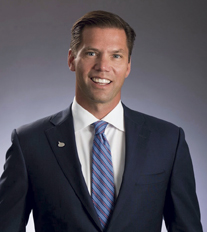In a remote work environment, are your employees really working?
The employees of tomorrow are here. They want unlimited vacation time, a positive work/life balance and the flexibility to work from home. While the first concept may seem far-fetched to employers—some actually do this—the last one is quite reasonable and, as one agency has discovered, beneficial.
Ericson Insurance Advisors, the Rough Notes October 2015 Agency of the Month, rolled out remote work in March 2017. Eighteen employees of its staff of 22 work from home to some extent.
“It started with one employee who was commuting an hour each way,” says Co-President Spencer Houldin. “We started having her work from home two days a week and it worked really well. Where she was situated physically in the office was around two other people in very tight quarters. It was a much quieter place for everyone on the days she wasn’t there.
“One thing I love about remote working is that half of our team isn’t here on any given day; it cuts down on the noise and chitchat,” adds Houldin. “People are much more productive, whether they are here or at home because they’re focused on what they’re doing and aren’t distracted by water cooler talk.”
There are requirements for the agency’s employees to work remotely.
“We have a document that sets the expectations from both ends: what we expect from them and what they expect from us,” says Dayla Aita, chief operating officer. “We sit down with them ahead of time and make sure everyone is on the same page.
“In order to allow for coverage in all departments, everybody is assigned specific days of the week to work remotely,” she adds. “We have one day per week that’s considered an all-in day, which is the day we have team and department meetings.”
Brand-new employees are placed in a six-month waiting period, and designated work space must be available at the employee’s home.
“We don’t want them working from the kitchen table or on a laptop in the living room,” says Aita. “We provide an identical setup to what they have in the office with the computer, the monitors, phone, and any other equipment they may need. Aside from the designated work space we have to make sure that their Internet connection is stable.”
“It’s an investment,” adds Houldin. “We put the technology in everybody’s house and it costs a couple of thousand dollars per person. We’re investing $30,000 to $40,000 to have this setup, but we feel that in the long run, the ROI will pay off.”

—Spencer Houldin
Co-President
Ericson Insurance Advisors
Monitoring productivity
With employees working offsite, it’s important to make sure they are actually getting work done.
“We have employee monitoring software—Spector Pro—that we had been using prior to having remote work, so it wasn’t something we implemented specifically for this purpose,” says Aita. “We can generate reports in real time to make sure that employees are online and doing what they’re supposed to be doing.”
“Spector Pro is only accessible by my brother Peter (the other co-president of Ericson Insurance Advisors) and me,” explains Houldin. “We can measure keystrokes and see where they have been on the Internet. If their computer’s dormant for an hour, we can compare it to the phone records.”
If the employee wasn’t on the phone for that hour either, there may be some investigating to do.
“We can compare the at-home metrics to when they are in the office,” Houldin adds. “In every single case we have found that they are more productive when they are at home.
“We don’t run reports on a regular schedule,” he continues. “We ran them at the beginning to see how we were doing, but we’re firm believers that there’s a job to do. All of our account executives have a book of business that they are responsible for. If they’re getting the job done and we’re not getting negative feedback from clients, I have to believe that they’re being productive. I’m not going to manage by reports unless we think there’s a problem.”
Houldin says the agency does monitor cancellations and retention, premium growth, and cross-selling of books, whether the employee is in or out of the office.
Adds Aita: “Early on we were checking the productivity reports frequently to gauge whether there was a consistent pattern. Comparing days in the office and days out of the office, it’s pretty consistent.”
“However, there does tend to be a trend that as people get more comfortable we’ll start to see production slip off, as they throw in a load of laundry or take a walk in the back yard,” says Houldin. “We can compare week over week and year over year to keep an eye on productivity to make sure it doesn’t slip.”

—Dayla Aita
Chief Operating Officer
Ericson Insurance Advisors
“To work at home, an employee has to be a dedicated person,” says Aita. “That was certainly a factor when we started this—knowing our staff and making sure they have the right mindset to excel and work from home. When implementing remote work, take your time and know that it may not be a fit for everyone. The technology’s important, but there’s a huge trust factor in this.”
In addition to monitoring productivity on employees’ computers, the agency has the ability to track phone usage.
“We have a robust phone system that’s a complete voice-over-IP system,” Aita says. “MXIE, which is offered by Zultys, has detailed reports that can tell us how many calls they’ve taken, what numbers they’ve called, and how long they’ve been on a call. The system can also tell us when someone is available, not available, or out to lunch.”
“Another piece of technology we’ve adopted is Zoom; it’s software that allows colleagues to video chat,” says Houldin. “It’s easy to set up and use. Everybody has the capability; they all have Zoom and the cameras, but they tend to pick up the phone and call each other, which is fine. I think there is something powerful in being able to see each other.
“We’ve also adopted Chatter, which is an internal chat mechanism and part of Salesforce. If someone hears something or learns something that others could benefit from, he or she should post it to Chatter. Everyone should be starting their day by going to Chatter to see what was posted the day before.”
It works, but …
With a large percentage of Ericson’s employees taking advantage of the opportunity to work from home, it’s safe to say that the concept is well received.
“To take away the privilege at this point would be a real problem,” says Houldin. “Once you commit to it, I think you’re kind of stuck because I don’t think morale’s going to do too well if you tell someone they can work from home for two days a week and then a year later tell them you’re no longer offering that option.”
One employee, Shari Shimko, senior account executive, was hesitant about the idea; she was one of the holdouts who started working from home two days a week about four months ago.
“She had been working in the office for 31 years,” says Houldin. “This was a big change for her with her longevity with the company.”
“I do like it, but I have to admit I was one of the last people to sign up for this,” Shimko says. “I like to get up, get dressed, go to the office and interact with people. It was an adjustment at first, but there’s no difference between working in your home office and working at your desk at the agency. Clients don’t know.
“I was more concerned for the client. We don’t get a lot of walk-ins like we did before the days of technology. You don’t have the face-to-face interaction with clients as much as you used to. Life is busy. People are busy. And this works.
“It’s a nice option,” she continues. “We had a morning snowstorm one day in December, and I thought, ‘On days like this it’s even nicer.’ It definitely has its benefits.”
While remote work has its benefits, there have been minor concerns.
‘The sense of team has gone down,” says Houldin. “Employee A is out every Monday and Employee B is out every Tuesday, which means A and B don’t see each other. Some employees don’t see others except when we try to get everybody together on Wednesdays for our company meetings. When you don’t see your colleagues to the same degree, that sense of teamwork diminishes.”
“A challenge is having everyone in the office when we need them,” says Aita. “There are times when we have in-office meetings that we need to have on a non-all-in day. If a carrier rep needs to come into the office on a Thursday instead of a Wednesday, trying to organize schedules can get complicated.”
“Another drawback that I’m nervous about,” Houldin adds, “is losing the institutional educational knowledge that you gain just by being around other people. When I have a coverage question, I’ll go up to somebody else’s desk and ask. You lose that educational value when you’re not around other people.
“About ten years ago we had an employee who retired, moved out of state and then wanted to work part-time if there was work for her. We would email her change requests and she would make the changes to the policies. We noticed that after about a year she was losing her edge because she wasn’t around to hear the company reps and learn about changes in the systems and changes in coverage options, and very quickly she became outdated because she wasn’t physically involved anymore.”
Additional praise
“Given the talent retention problem, I believe that remote work is a huge retention tool for agencies,” says Houldin. “Our office is in a rural town in Connecticut with 2,500 people. One reason we wanted to implement working from home was so we could hire someone anywhere in the country to be a CSR or producer because you don’t need to physically be in Connecticut.
“We have a couple of key employees whose kids are grown, they have no ties here, and they’re starting to question whether they like the cold weather. Part of this is a defensive move because I know I could hold onto them as employees because they’ve already learned how to work remotely and they can go anywhere they want.
“In the Northeast, we typically have six to ten snow days a year when employees wouldn’t be able to travel and the office would be shut down,” he continues. “There’s no such thing as a snow day anymore. We also have illnesses in the office. We have a rule that if you’re coming down with something, just work from home and keep everyone else healthy. Two years ago we had a bad winter and were just passing a bug around. It’s a huge benefit to be able to keep illness out of the office.”
As for implementing working from home, “You need a solid four months to work it out, whether it’s the technology or everyone in the office getting used to the process,” says Aita. “It’s an adjustment for everyone. Once you work through any kinks and flesh it all out, it’s a benefit for everyone.”
“You have to be thoughtful about how you do it,” adds Houldin. “We rolled it out slowly; we didn’t just say ‘as of January 1 everybody can work from home.’ We were integrating two or three employees a month to start it off.
“Independent agencies need to think about how the employee of the future wants to work, especially Millennials. We have to start thinking outside the box and trusting our people and our technology.”
By Christopher W. Cook






